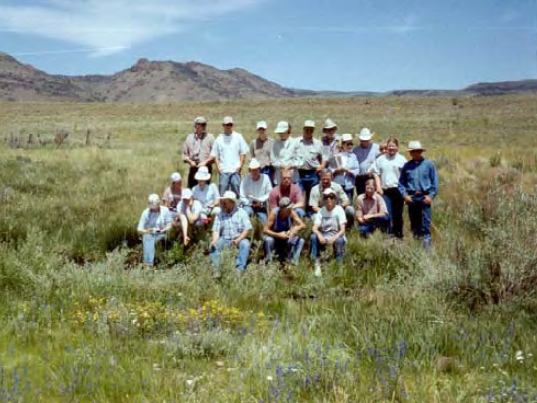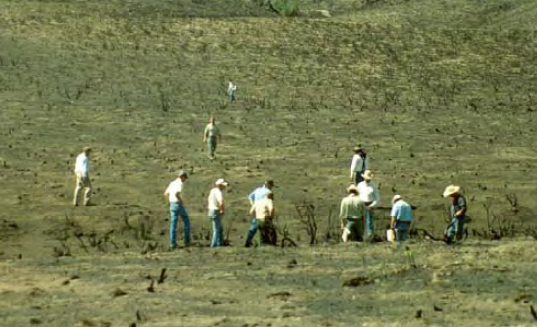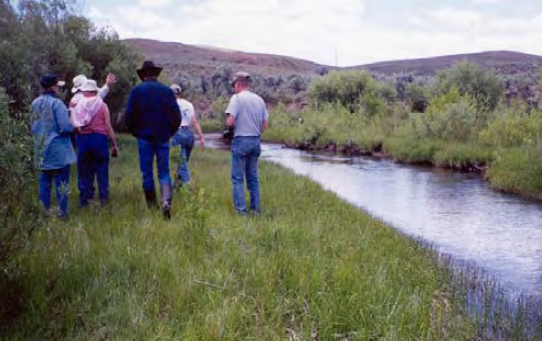Introduction
This fact sheet is one in a series evaluating impacts of community partnerships that address natural resource issues in northeastern Nevada. Beginning in the mid-1990s, community members with diverse views and backgrounds began to cooperatively evaluate and address several natural resource issues that had the potential to affect the quality of life in northeastern Nevada. Earlier fact sheets (McAdoo and Carpenter 2002, McAdoo et al. 2003a, both accessible at www.unce.unr.edu) present case histories and impacts of two weed action groups formed in Elko County. Another fact sheet evaluates collaborative resource stewardship impacts of the Northeastern Nevada Stewardship Group (McAdoo et al. 2004). The purpose of this fact sheet is to evaluate the impacts of the Cottonwood Ranch Holistic Management Team (HMT). This Team, established in 1995, was borne of conflict associated with the impacts of livestock grazing on public lands, particularly with regard to vegetation along streams (commonly referred to as riparian areas).
History and Background
During the early 1990s, a history of dissatisfaction and disagreement between land management agencies and Cottonwood Ranch personnel culminated in an impasse that spelled the possibility of severe economic loss for the ranch and a black eye for the agencies. Several interested citizens and the land management agencies agreed to engage in a process formerly called Holistic Resource Management (Savory and Butterfield 1988) and now officially known as Holistic Management. This process integrates ecological, social, and financial considerations into a “holistic” plan in an effort to meet the needs of diverse land users. An Environmental Assessment was completed to officially launch the project, with the understanding that it would be re-evaluated at the end of a 5-year period. The original team included the Cottonwood Ranch family and staff, Bureau of Land Management (BLM), U.S. Forest Service (USFS), University of Nevada Cooperative Extension (UNCE), Nevada Department of Wildlife (NDOW), Natural Resources Conservation Service (NRCS), Nevada Division of Forestry (NDF), U.S. Fish and Wildlife Service (USFWS), private property groups, area ranchers and neighbors, concerned citizens of northern Nevada and southern Idaho, public land recreationists, and the Elko County Commission. First-year project funding was provided by the Elko County Commission, and subsequent funding was provided by a Nevada Sustainable Agricultural Research and Education (SARE) grant, and the Cottonwood Ranch owners. The original HMT consisted of 40 members and was initially led by two certified Holistic Management facilitators (Savory and Butterfield 1998).
The Cottonwood Ranch is located in northern Elko County and has 1,200 acres of private land along with permitted livestock use on approximately 18,000 acres each of BLM- and USFS-administered land. The landscape is diverse, including large meadows in the privately-owned pastures, sagebrush-grass vegetation on lower elevation public land, and a mixture of mountain shrub, aspen, curl-leaf mountain mahogany, and conifers in higher elevations. Riparian vegetation is dominated by aspen, willow, and alder along perennial streams that bisect the area. Because of this vegetation diversity, the ranch and its allotments contain important wildlife habitat and a diversity of species. Specifically, wildlife habitat includes summer range for mule deer and antelope, yearlong habitat for elk and sage grouse, breeding habitat for songbirds, and habitat for many other species of wildlife. The perennial streams also provide aquatic habitat for trout, along with beaver ponds inhabited by spotted frogs.
Holistic Management Goals
The Holistic Management approach involves a consensus-based decision-making model that encourages diverse participants to consider the economic, environmental, and social impacts of a decision before it is implemented. The Cottonwood HMT discussed various values, ideas, and viewpoints, including “out of the box” thinking, as they worked together to develop a vision for effectively managing a piece of land.
The first task for HMT members was to develop a three-part goal statement. Participants agreed on:
- quality of life attributes such as financial and family security, trust, integrity, free communication among team members, unity of purpose, and synergy;
- forms of production that included collaboration, clean water, a productive livestock herd, diverse recreational opportunities, healthy riparian areas, financial stability, knowledge of the land/awareness of impacts, less control/more freedoms, and team nurturing; and
- a future landscape description that included such varied concepts as more flowers on the hillsides, sustainable plant and animal populations, vegetation mosaics, intact archeological sites, and an abundance and diversity of wildlife.
Holistic Management Implementation
Holistic Management was officially implemented on an interim basis in 1996 through the BLM’s Decision Record for Environmental Assessment (EA) # BLM/EK/PL-96-103 and continues today. Under the Holistic Management process, management is guided by a collaborative team that sets goals and objectives for the public land grazing allotment. A Memorandum of Understanding (MOU) signed by the BLM, USFS, NDOW, Elko County Commission, and the Cottonwood Ranch owners promised cooperation that enabled the Holistic Management process. Each year, the team creates a “biological plan,” establishing grazing use and patterns for the upcoming year and specifying how livestock are to be moved through the various grazing units.
The Cottonwood Allotment is divided into four BLM pastures and two Forest Service pastures. Through natural barriers and electric fences, each pasture was further divided into a series of smaller grazing units that are identified as subunits or paddocks. These paddocks are smaller more manageable units used to: assure appropriate stock density, allow proper timing for vegetation recovery, evaluate the effectiveness of the grazing system, and monitor impacts through time. Over the years, the HMT has identified the need for water developments and additional fencing that were implemented to achieve the planned livestock distribution.
At the beginning of the Holistic Management effort, livestock numbers on the ranch were doubled and a grazing system based on high intensity/short duration livestock grazing was implemented.
This system consists of moving a larger herd of cattle over the landscape more quickly than traditional grazing programs, controlling the timing and duration of grazing, and changing the order in which the paddocks are grazed each year to allowed the grazed plants to recover and thrive. It is important to note that the increase in livestock numbers, grazing season changes, and management flexibility were achieved without any appeals or protests from environmental groups, a tremendous credit to the Holistic Management process.
Since 1996, when the Holistic Management process began, the Cottonwood HMT has met at least quarterly each year to plan, review progress, and conduct field tours (Figures 1 – 4). During this time, the team was provided training to assist them with the implementation of their management strategies. This training included initial and refresher courses on the Holistic Management process, upland and riparian monitoring techniques, fire ecology, and the Proper Functioning Condition (PFC) of riparian areas (provided by UNCE personnel). Ranch personnel also received formal training on low stress livestock handling, a technique used to control cattle movements more effectively and improve cattle performance by reducing the long-term stress associated with traditional livestock handling techniques. The method also helps reduce grazing impacts on riparian areas. Vegetation monitoring sites (including photopoints) were established so that management changes could be made if and when indicators showed that desired results were not being achieved. Once the Holistic Management process was in place, the use of paid, certified Holistic Management facilitators was intermittent through the years.
In the fall of 1999, the Nevada Riparian Cadre, assisted by several Cottonwood Ranch HMT members, conducted a PFC evaluation of the streams flowing through the ranch. This approach uses a series of 17 attributes related to hydrology, vegetation, and soil erosion and deposition to determine whether a stream is functioning properly, functioning at risk, or not functioning (Prichard 1993).

Figure 1. Cottonwood Ranch owner manager, Agee Smith, pointing out areas impacted by wildfire during 2000.

Figure 2. Cottonwood Ranch HMT members pose at an annual photo-point during a field tour.

Figure 3. Cottonwood Ranch HMT members touring area of 2000 wildfire.

Figure 4. Nevada Riparian Cadre and Cottonwood Ranch HMT members evaluating the riparian area along a perennial stream.
Some Bumps Along the Way
Implementation of the HMT’s strategy was not always perfect. During the first two years, permitted activities under the Holistic Management process were not in complete compliance with the Forest Plan with respect to maximum allowable forage utilization levels by livestock. An administrative action resulted in agreement between the USFS and the ranching operation to adjust livestock use to a shorter grazing period on USFS land, beginning with the 1998 grazing season. Livestock control improved in 1998 due to a combination of experience gained, better use of herders, and the use of yearling cattle instead of cow/calf pairs.
In August of 2000, a lightning-caused wildfire burned approximately 6,000 acres of BLM land within the Cottonwood allotment and about 5,000 acres of USFS land. The plant communities within much of the burned areas were in good condition prior to the burn, but some areas experienced moderate to high burn intensity and required efforts to restore shrubby perennial vegetation. The fire impacted vast areas of sagebrush and bitterbrush-dominated range, with initial negative impacts on habitat for sage grouse, mule deer, and other wildlife species. The fire also swept through some of the established vegetation monitoring sites. Because the native grasses were expected to recover for the most part, revegetation emphasized bitterbrush and sagebrush. Construction of a fence on BLM land separated burned and unburned areas to allow re-establishment of native vegetation and provide protection for critical wildlife habitat. Burned areas of the BLM allotment (except for an experimental area) were not grazed by livestock grazing for two growing seasons after the fire. The USFS allotment was ungrazed for two and a half years.
Impact Evaluation
Based on management suggestions from the HMT, the Cottonwood Ranch has worked collaboratively to modify their livestock grazing plans in consideration of multiple rangeland resource values and develop appropriate adaptive management strategies. Even as early as 1997, sampling by BLM range specialists showed that riparian habitat along streams of the Cottonwood Ranch were responding favorably to strategic changes in livestock management. An evaluation conducted in 1999 showed that 13.5 miles of stream were functioning properly, 19.3 miles were functioning at risk, and 1.1 miles were nonfunctioning. Approximately 75% of the “at risk” reaches were judged to be in an upward trend, with only 12% showing downward trend and 13% showing no apparent trend.
For the “at risk” stream reaches, the PFC checklist provided strong clues for setting management changes and monitoring based on objectives. Some reaches need grazing management that favors willows. Other reaches lack the fine soil necessary to produce herbaceous vegetation for streambank stabilization, and some areas need to expand their floodplain after recent channel incision. Improved livestock management is expected to bring about these changes over time. Current riparian monitoring plots established in 2000 focus on “at risk” stream reaches and on the needed attributes, using a combination of photos, “greenline” vegetation composition, woody species regeneration, and/or width between stabilized banks.
The BLM re-evaluation of the Holistic Management process scheduled for 2001 was postponed until 2003 because of other BLM priorities, but the agency renewed its commitment to continue with the process. As a result of the Cottonwood Allotment Reevaluation, the BLM recommended that livestock grazing continue in accordance with the flexible Holistic Management process. This recommendation was based on the conclusion that: “Through the analysis of data within this document, riparian conditions, utilization objectives, periods of use, and actual use levels within each pasture have been in conformance with multiple use objectives and Standards for Rangeland Health.” This recommendation from the land management agency is a positive outcome of the “experimental” holistic management process.
Of 24 evaluated objectives, 9 were met and 11 were partially met, with 1 undetermined, 1 met on unburned sites only, and only 2 not met. The latter two were not a result of improper grazing, but rather because of the large wildfire (in the case of a mule deer habitat objective) and because of a failed bighorn sheep stocking attempt that was outside the scope of the Cottonwood Allotment management.
Although the USFS has not completed an in-depth evaluation of the Cottonwood Ranch Holistic Management, a 2003 report indicated that the USFS allotment met agency utilization standards as the result of the ranch using a “rider” to move livestock away from sensitive areas and changing season of use for browse species.
The Cottonwood Ranch owner/operators experienced positive change during the nine years of Holistic Management. At the outset of this project, they owned 65 cows and had to lease cattle to achieve full stocking rates (400 – 800 head). Within five years, the ranch was able to stock the ranch with its own cattle. The ranch has also successfully diversified its operation, offering a guest lodge and big-game guide services.
In 2000, a neighboring ranch family that had been participating on the Cottonwood HMT expressed the desire to form another HMT for their operation. By 2001, the two teams had formed an umbrella organization, the Shoesole Resource Management Group, in part to facilitate the formation of other HMTs. Private and public lands impacted by this collaborative resource stewardship approach now total more than 160,000 acres. Both teams continue to move toward achieving balanced collaborative management approaches for economic and ecological sustainability. At least two additional ranches have expressed interest in starting their own HMTs.
In the fall of 2004, Agee Smith, Cottonwood Ranch owner/manager was given the “Rancher of the Year” award at the Nevada Cattlemen’s Association’s Annual Meeting. Nominated for this award by the BLM,
“Smith was chosen for his innovative and unique management practices, which include a Holistic Management grazing system. Smith's passion for livestock grazing and rangeland health is evidenced by the success his efforts on managing the livestock have had on the vegetative habitats.”
Conclusions
Perhaps the best indication of the Cottonwood Ranch HMT’s effectiveness is its success in bringing together diverse interests to work toward common goals. The team has experienced ups and downs, due in part to interrupted continuity from changes in membership through the years, the learning curve, and the slow process of building trust. However, based on results of a recent survey of the four northeastern Nevada counties, the vast majority of citizens (80%) prefer such collaborative approaches for resource stewardship to debating resource use conflicts in court battles (McAdoo 2003). Grassroots collaborative approaches to resolution of these issues are gaining momentum in many western communities, and news of the Cottonwood Ranch HMT’s success is spreading. According to team member Marge Kaiser of the Sierra Nevada Deep Ecology Institute (an environmental protection organization), on June 21, 2004:
“Cottonwood is the talk of the town – literally - in the Grass Valley/Nevada City, California area. I had a half-hour interview on KVMR last week and another one on KNCO today, talking about the Cottonwood Holistic Management project…Folks around here are very thirsty for solutions to environmental problems instead of polarization.”
References
- McAdoo, J.K., and J. Carpenter. 2002. Woad Warriors – Community Weed Awareness. Univ. of Nevada Cooperative Extension Fact Sheet. FS- 02-62. 4 pp.
- McAdoo, J.K. 2003. Public Opinions about Rangeland Resources in Northeast Nevada. Rangelands 25(4): 51-56.
- McAdoo, J.K., J. Wilkinson, and D. Rafferty. 2003a. Spring Creek Weed Action Team (SWAT) – A Case Study. Univ. of Nevada Cooperative Extension Fact Sheet. FS-03-04. 4 pp.
- McAdoo, J.K., L. Collord, and G.N. Back. 2004. Working Together for Healthy Landscapes and Quality Lifestyles – Impact Evaluation of the Northeastern Nevada Stewardship Group. Univ. of Nevada Cooperative Extension Fact Sheet. FS-04-68. 6 pp.
- Pritchard, 1993. Riparian Area Management – Process for Assessing Proper Functioning Condition. Tech. Ref. 1737-9. USDI Bureau of Land Management Service Center, Denver, CO. 51pp.
- Savory, A., and J. Butterfield. 1988. Holistic Management: A New Framework for Decision Making. Island Press., Wash. DC & Covelo, CA.
McAdoo, K., Davison, J., Swanson, S., and Smith, A.
2004,
Impact Evaluation of Cottonwood Ranch Holistic Management,
Extension | University of Nevada, Reno, FS-04-67


